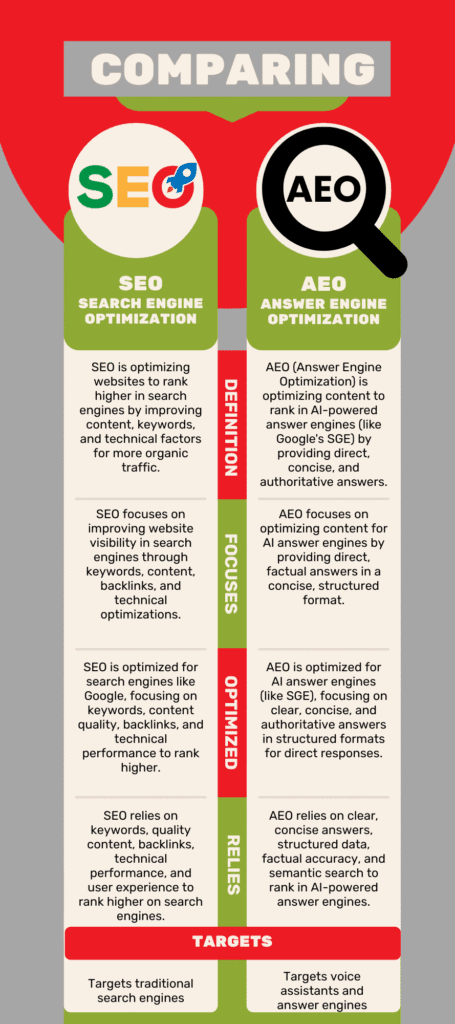
AEO vs SEO: The Future of Search and Why You Can’t Afford to Be Left Behind
The digital landscape is constantly evolving, and just when you think you’ve mastered one concept, a new one emerges. If you’ve been in the world of digital marketing, you’re probably familiar with SEO (Search Engine Optimization)—the art and science of optimizing your website to rank higher in search engines like Google. But there’s a new player in town, and it’s called AEO (Answer Engine Optimization).So, what is AEO, and why does it matter? More importantly, how does it differ from SEO, and why should you act now to adapt? Let’s explore how AEO is reshaping the way we think about search, why it’s essential for your business, and how to avoid getting left in the dust while your competitors take the lead.
What Is SEO (and Why It’s Still Important)?
Let’s start with the basics. SEO is all about optimizing your website to appear prominently on search engine results pages (SERPs). It’s a tried-and-true method that focuses on things like:
- Keywords: Using relevant terms that people search for.
- Backlinks: Building credibility through links from other trusted websites.
- Content Optimization: Crafting high-quality, valuable content that meets user needs.
- Technical SEO: Ensuring your website is fast, mobile-friendly, and easy to navigate.
SEO is still relevant because search engines like Google rely on these factors to deliver results to users. But here’s the catch: search engines are evolving, and so are user behaviors.
What Is AEO (Answer Engine Optimization)?
AEO, or Answer Engine Optimization, takes search to the next level. It focuses on optimizing your content to provide direct answers to user queries, especially in the context of voice search and AI-driven assistants like Siri, Alexa, and Google Assistant.Think about it: when you ask Alexa, “What’s the best Italian restaurant near me?” you don’t get a list of links. You get a direct answer. That’s where AEO comes in—it’s about making sure your brand is the one providing that answer.AEO shifts the focus from search results to answer results. It’s about ensuring your content is structured and optimized in a way that search engines and AI assistants can easily extract and deliver as answers.
How AEO Differs from SEO
While SEO and AEO share some similarities, their goals and approaches are different. Here’s a quick breakdown:
The key difference? SEO is about visibility, while AEO is about relevance and immediacy. In an age where users expect instant answers, AEO is becoming increasingly vital.
Why AEO Matters (and Why You Need to Act Now)
The rise of AEO isn’t just a trend—it’s a reflection of how people are using the internet differently. Here’s why it matters:
- Voice Search Is Booming By 2025, it’s estimated that half of all searches will be voice-based. From asking Siri for directions to querying Alexa about the weather, people are embracing voice assistants for quick, hands-free answers. If your content isn’t optimized for voice search, you’re missing out on a huge portion of traffic.
- AI Assistants Are the New Gatekeepers AI-powered platforms like Google Assistant, Alexa, and Siri rely on structured data to provide answers. If your website isn’t optimized to deliver concise, accurate information, you’re invisible to these platforms.
- User Expectations Are Changing People want instant answers, not a list of links. AEO ensures your content meets this demand, positioning your business as a trusted source of information.
- Competitive Edge Many businesses are still focused solely on traditional SEO, which means there’s a massive opportunity to get ahead by embracing AEO early. By the time your competitors catch on, you’ll already be a trusted voice in the answer engine space.
How to Optimize for AEO
Now that you understand the importance of AEO, how do you get started? Here are some actionable steps to ensure your content is ready for the future of search:
1. Focus on Answering Questions
- Identify common questions your target audience is asking.
- Use tools like Google’s “People Also Ask” or AnswerThePublic to find query-based topics.
- Create content that provides clear, concise answers to these questions.
2. Use Structured Data (Schema Markup)
- Add schema markup to your website to help search engines understand your content.
- Structured data can improve your chances of appearing in featured snippets and voice search results.
3. Optimize for Voice Search
- Use natural, conversational language in your content, as that’s how people speak when using voice assistants.
- Include long-tail keywords that mimic how people ask questions verbally (e.g., “What’s the best way to start a blog?”).
4. Prioritize Mobile Optimization
- Voice searches are often done on mobile devices, so ensure your website is mobile-friendly.
- Make sure your site loads quickly and is easy to navigate on smaller screens.
5. Provide Localized Answers
- Voice searches often include local intent (e.g., “restaurants near me”), so optimize for local SEO by claiming your Google My Business listing and including location-based keywords.
The Cost of Falling Behind
Here’s the reality: if you’re not optimizing for AEO, you’re already behind. As user behavior shifts toward voice and AI-driven search, businesses that rely solely on traditional SEO will see their visibility—and revenue—decline.The good news? It’s not too late to get ahead. By embracing AEO now, you can future-proof your digital strategy, gain a competitive edge, and ensure your business stays visible in an increasingly answer-driven world.
Don’t Get Left Behind—RojamDz.com Is Here to Help
Navigating the shift from SEO to AEO can be overwhelming, but you don’t have to do it alone. At RojamDz.com, we specialize in helping businesses adapt to the future of search. From optimizing your content for voice search to implementing structured data, we provide the tools and expertise you need to stay ahead of the competition.The world of search is evolving—are you ready to evolve with it? Visit RojamDz.com today and let us help you optimize for the next generation of search. Don’t get left behind. The future is now! 🚀


